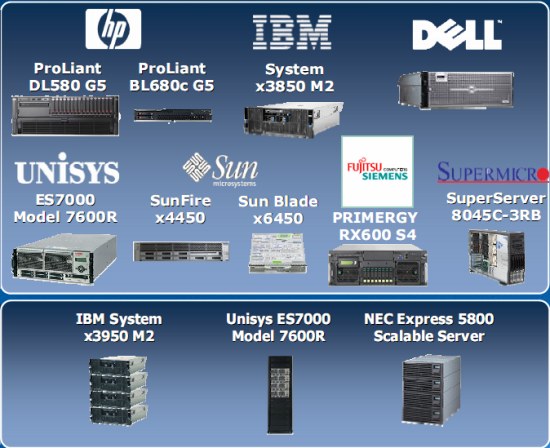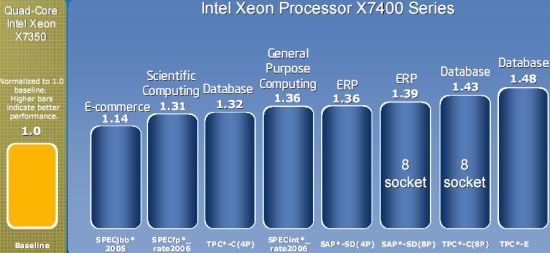Intel Xeon 7460: Six Cores to Bulldoze Opteron
by Johan De Gelas on September 23, 2008 12:00 AM EST- Posted in
- IT Computing
Intel's Own Benchmarking
These machines are indeed suited for other kind of tasks. We are talking about a heavy backend server, commonly used for huge databases and two/three tier ERP applications. Intel's own benchmarking results reflect this.
Intel compares the four- or eight-way X7460 (six cores at 2.66GHz) to the previous generation X7350 (four cores at 2.93GHz). Two results are particularly interesting. Let us start with the worst result: SPECjbb still seems to be limited by bandwidth despite the massive 16MB L3. The SAP results are interesting as the Xeon X7460 scales quite better than its predecessor. Notice how the eight socket results show a larger gap with the eight socket X7350 than when Intel compared a four socket X7460 and a four socket X7350. How does all this compare to AMD?
Third Party Benchmarking
Almost all the large players in the server market have adopted the Xeon 74xx. Below you can see an overview of the available systems. The systems on top have four sockets, while the systems in the lower half have eight to 16 sockets.

Servers available with the Xeon 74xx
Now let's see how these servers perform. Take a look at the TPC benchmarks that IBM and HP published. We'll compare them with the best score available for quad-core AMD Opteron.
- 635k TpmC ($1.10/TpmC) HP ProLiant DL580G5 (4x 2.66GHz Xeon X7460, 256GB, MSQL 2005, Win 2003)
- 1201k TpmC ($1.99/TpmC) IBM System x3950 M2 (8x 2.66GHz Xeon X7460, 512MB, DB2, RHEL 5)
- 472k TpmC (1.17/TpmC) HP DL585 (4x Opteron 8360 2.5GHz, 256GB, MSQL 2005, Win 2003)
The current Opterons do not scale very well from four to eight sockets and do not reach the higher clock speeds they need. The Xeon X7460 is a clear winner here: HP delivers a server with a very high price/performance ratio while IBM produces an expensive server platform that scales so well that it is out of reach of AMD. IBM delivers incredible high numbers thanks to its proprietary x3950 chipset server family. If money is not an issue, the x3950 is simply unbeatable in x86 land. The irony is that the x3950M2 is even a serious threat to the RISC market where IBM is so strong. Let's check out the ERP numbers.











34 Comments
View All Comments
JarredWalton - Tuesday, September 23, 2008 - link
Heh... that's why I love the current IBM commercials."How much will this save us?"
"It will reduce our power bills by up to 40%."
"How much did we spend on power?"
"Millions."
[Cue happy music....]
What they neglect to tell you is that in order to achieve the millions of dollars in energy savings, you'll need to spend billions on hardware upgrades first. They also don't tell you whether the new servers are even faster (it's presumed, but that may not be true). Even if your AC costs double the power bills for a server, you're still only looking at something like $800 per year per server, and the server upgrades cost about 20 times as much every three to five years.
Now, if reduced power requirements on new servers mean you can fit more into your current datacenter, thus avoiding costly expansion or remodeling, that can be a real benefit. There are certainly companies that look at density as the primary consideration. There's a lot more to it than just performance, power, and price. (Support and service comes to mind....)
Loknar - Wednesday, September 24, 2008 - link
Not sure what you mean: "reduced power requirements means you can fit more into your DC". You can fill your slots regardless of power, unless I'm missing something.Anyway I agree that power requirement is the last thing we consider when populating our servers. It's good to save the environment, that's all. I don't know about other companies, but for critical servers, we buy the most performing systems, with complete disregard of the price and power consumption; because the cost of DC rental, operation (say, a technician earns more than 2000$ per year, right?) and benefits of performance will outweigh everything. So we're so happy AMD and Intel have such a fruitful competition. (And any respectable IT company is not fooled by IBM's commercial! We only buy OEM (Dell in my case) for their fast 24-hour replacement part service and worry free feeling).
JarredWalton - Wednesday, September 24, 2008 - link
I mean that if your DC has a total power and cooling capacity of say 100,000W, you can "only" fit 2000 500W servers in there, or you could fit 4000 250W servers. If you're renting rack space, this isn't a concern - it's only a concern for the owners of the data center itself.I worked at a DC for a while for a huge corporation, and I often laughed (or cried) at some of their decisions. At one point the head IT people put in 20 new servers. Why? Because they wanted to! Two of those went into production after a couple months, and the remainder sat around waiting to be used - plugged in, using power, but doing no actual processing of any data. (They had to use up the budget, naturally. Never mind that the techs working at the DC only got a 3% raise and were earning less than $18 per hour; let's go spend $500K on new servers that we don't need!)